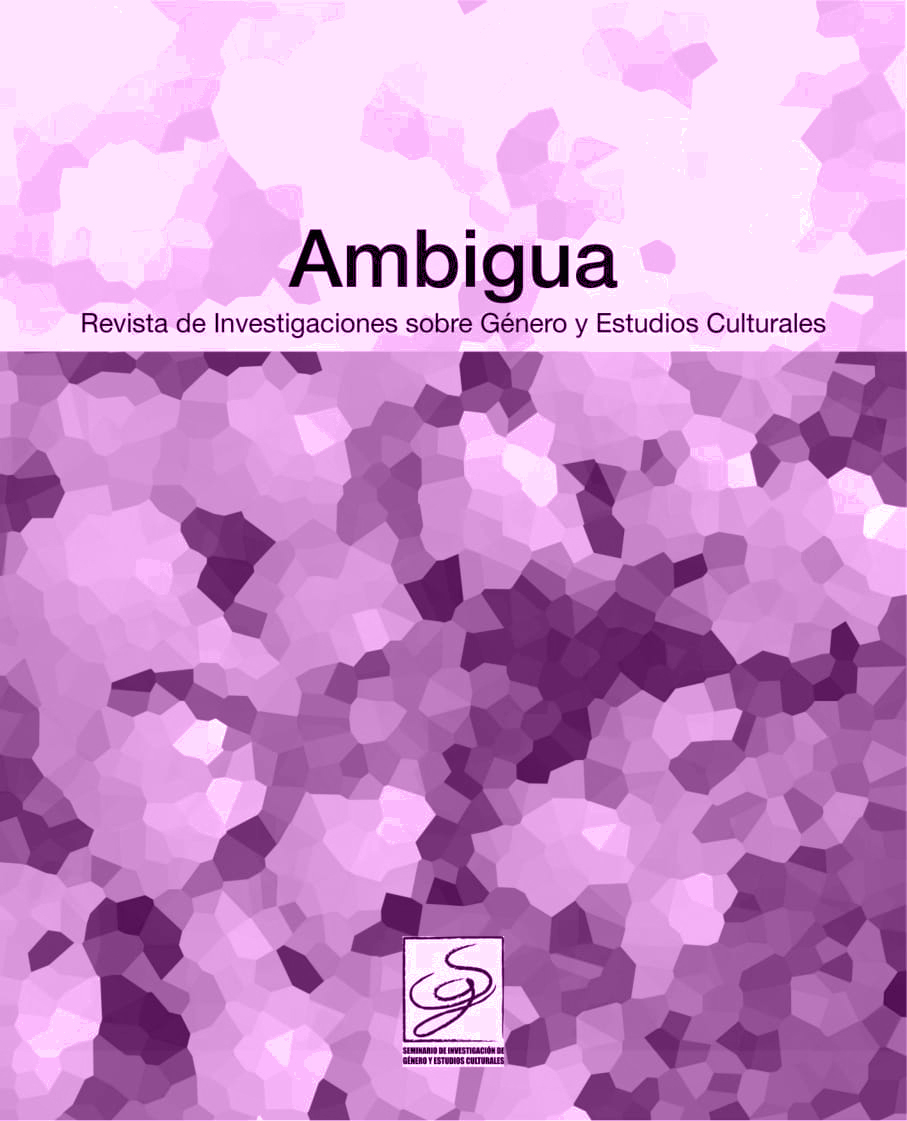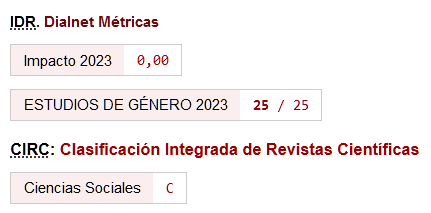Las grafiteras, artistas y muralistas transgrediendo los roles de género dentro de la gráfica urbana de Aguascalientes
DOI:
https://doi.org/10.46661/ambigua.5094Paraules clau:
mujeres, pintas, grafiti, intervenciones, roles, género, transgresiónResum
Las actividades del grafiti, street art y muralismo urbano se caracterizan por ser prácticas que han sido vinculadas principalmente con la figura masculina debido a los riesgos físicos que les suponen a los participantes. Sin embargo, paulatinamente la mujer se ha incorporado a las dinámicas de intervención gráfica de los espacios del territorio hidrocálido. Por lo que en el artículo se explican los estereotipos de género y los actos que realizan las mujeres grafiteras, artistas y muralistas para transgredir las ideas culturales e históricas que limitan y condenan su actuación dentro de los movimientos gráfico-callejeros de la ciudad de Aguascalientes. La actividad gráfica femenina se abordó desde los estudios de género para dilucidar la complejidad de los elementos culturales que definen socialmente a las identidades femeninas y masculinas dentro de la sociedad. Además, de analizar las dinámicas que perturban los órdenes establecidos destinadas a la transgresión de las ideas que determinan el deber ser de la figura femenina. Ello, fue posible a la aplicación de entrevistas a profundidad que proporcionaron información sobre su quehacer en los movimientos. Los resultados que se obtuvieron se asociaron con la comprensión de los actos que utilizan las mujeres para la transgresión de los roles de género en los movimientos del grafiti, street art y muralismo. Así como, las prácticas que elaboran para mantenerse activas. Esto, posibilitó que se concluyera que la mujer se presenta en los espacios públicos como una persona capaz y valiente de reproducir las dinámicas callejeras de los movimientos en Aguascalientes.
Descàrregues
Referències
Charlier, Sohie & Caubergs, Lisette. El proceso de empoderamiento de las mujeres. Guía metodológica. Francia: Femes y Developpement. 2007. Consultado en: http://www.dhls.hegoa.ehu.eus/uploads/resources/4668/resource_files/proceso_empoderamiento_mujeres_CFD.pdf
De la villa, A. Rocio. Crítica de arte desde la perspectiva de género. Investigaciones Feministas , 4, 10-23. 2013. DOI: https://doi.org/10.5209/rev_INFE.2013.v4.41874
González Jiménez, Rosa. Estudios de género en educación. Una rápida mirada. Revista Mexicana de Investigación Educativa , 14 (42), 2009, pp. 681-699.
González, Marcela. (16 de febrero de 2019). 60% de las mujeres han sido víctimas de violencia de género. Hidrocálido Digital. http://www.hidrocalidodigital.com/local/articulo.php?idnota=152951
González, P. Teresa. Desigualdad, mujeres y religión. Sesgos de género en las representaciones culturales religiosas. Cuestiones de género: de la igualdad y la diferencia. (5), 2010, pp. 467-505. Consultado en: http://revpubli.unileon.es/ojs/index.php/cuestionesdegenero/article/view/3797/2673
Hernández G, Cristina. (10 de noviembre de 2017). Hay en Aguascalientes Cerca de 2 mil Hectáreas de Terrenos Baldíos. Página 24. https://pagina24.com.mx/2017/11/10/local/hay-en-aguascalientes-cerca-de-2-mil-hectareas-de-terrenos-baldios/
Hernández, H. Luisa. Mujeres y grafiti en México, algunas reflexiones sobre género y juventud. Voces de jóvenes. 2018, pp. 63-74.
Kozielecki cita por Mamzer, Hanna. La identidad y sus transgresiones. La ventana (24). 2006, pp. 118-149.
Lamas, Matha. Diferencias de sexo, género y diferencia sexual. Cuicuilco , 7 (18). 2000, pp. 1-24. Consultado en: https://www.redalyc.org/pdf/351/35101807.pdf
Mora Legaspi, Mario. (7 de enero de 2019). La ciudad con muy buena infraestructura. El sol de centro. https://www.elsoldelcentro.com.mx/local/la-ciudad-con-muy-buena-infraestructura-2891589.html
Muñoz, L. Pilar. Arte feminista. Empoderamiento de las mujeres en el arte. El ejemplo de Paula Rego. Cuadernos Kóre. Revista de historia y pensamiento de género (8). 2013, pp. 237-265. Consultado en: https://e-revistas.uc3m.es/index.php/CK/article/view/2042/987
Orsini, Marta. El concepto de empoderamiento en los estudios de género y en la prensa femenina. I congreso internacional de comunicación y género (págs. 951-971). Sevilla: Universidad de Sevilla, Facultad de Comunicación. 2012. Consultado en: https://idus.us.es/bitstream/handle/11441/34591/Pages%20from%20LIBRO%20ACTAS%20I%20CONGRESO%20COMUNICACI%D3N%20Y%20G%C9NERO-6.pdf;jsessionid=13C19B3F34BCCA20EC7B25812F338CE2?sequence=1
Ramírez, Alejandra. (24 de junio de 2019). Ocurre un suicidio cada 55 horas en Aguascalientes. Newsweek, México. https://newsweekespanol.com/2019/06/ocurre-un-suicidio-cada-55-horas-en-aguascalientes/
Redacción. (11 de mayo de 2015). El municipio de Aguascalientes cuenta con más de tres millones de metros cuadrados de áreas verdes. La Jornada Aguascalientes. https://www.lja.mx/2015/05/el-municipio-de-aguascalientes-cuenta-con-mas-de-tres-millones-de-metros-cuadrados-de-areas-verdes/
Redacción. (13 de agosto de 2019). En lo que va de 2019 se han creado 306,014 empleos en Aguascalientes. La Jornada Aguascalientes. https://www.lja.mx/2019/08/en-lo-que-va-de-2019-se-han-creado-306014-empleos-en-aguascalientes/
Rodriguez Madera, Sheilla y Toro, Alfonso José. Ser o no ser: La transgresión del género como objeto de estudio en la Psicología. Avances en psicología clínica latinoamericana (20). 2002, pp. 63-78.
Romo, Alejandro. (17 de julio de 2019). Disminuye percepción de inseguridad en Aguascalientes: INEGI. Newsweek. México. https://newsweekespanol.com/2019/07/disminuye-percepcion-de-inseguridad-en-aguascalientes-inegi/
Solano, B. L. Discriminación y racismo en Aguascalientes, ciudad de la gente buena. Ra Ximhai , 14 (2). 2018, pp. 149-160. Consultado en: https://www.redalyc.org/jatsRepo/461/46158063009/html/index.html
Valdéz, Ricardo. (16 de agosto de 2012). Aguascalientes es el tercer estado en el país con mayor porcentaje de población católica. La Jornada. Aguascalientes. https://www.lja.mx/2012/08/aguascalientes-es-el-tercer-estado-en-el-pais-con-mayor-porcentaje-de-poblacion-catolica/
Descàrregues
Publicades
Com citar
Número
Secció
Llicència
Drets d'autor (c) 2020 Sergio Raúl Recio Saucedo

Aquesta obra està sota una llicència internacional Creative Commons Reconeixement-NoComercial-CompartirIgual 4.0.
Las autorías que publican en esta revista están de acuerdo con los siguientes términos:
- Los autores conservan los derechos de autor y garantizan a la revista el derecho de ser la primera publicación del trabajo al igual que licenciado bajo Licencia Creative Commons Atribución-NoComercial-CompartirIgual 4.0 Internacional la publicación inicial en esta revista: Attribution-NonCommercial-ShareAlike 4.0 International (CC BY-NC-SA 4.0)
- Las autorías pueden establecer por separado acuerdos adicionales para la distribución no exclusiva de la versión de la obra publicada en la revista (por ejemplo, situarlo en un repositorio institucional o publicarlo en un libro), con un reconocimiento de su publicación inicial en esta revista.
- Se permite y se anima a las autorías a difundir sus trabajos electrónicamente (por ejemplo, en repositorios institucionales o en su propio sitio web) antes y durante el proceso de envío, ya que puede dar lugar a intercambios productivos, así como a una citación más temprana y mayor de los trabajos publicados (Véase The Effect of Open Access) (en inglés).
- Esta revista no cobra por publicar, es decir, no tiene APC's (the journal does not have article processing charges)
- Esta revista tampoco cobra ninguna tasa por el envío/presentación de trabajos (the journal does not have article submission charges)









